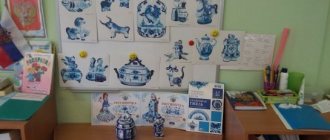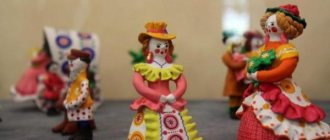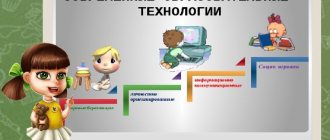Productive activities for preschool children
Productive activity of preschoolers is the right direction in preparing the future first-grader for education.
The formation, development and formation of a child’s personality is one of the most relevant, important and responsible areas of activity for specialists involved in the field of pedagogy and child psychology. One of the main tasks that must be constantly performed in this direction is the use of various styles, forms and methods, including productive activities.
Contents and types of productive activities in the senior preschool group of preschool educational institutions
Definition 1
Productive activity is the performance of types of work that occupy a central place in the life of a preschooler and are of a modeling nature (modeling, artistic creativity, design, appliqué).
Such productive activities of preschoolers are focused on creating models of real-world objects in various ways. This helps to reveal the child’s creative potential, develop his intellect, activate his work skills, develop imagination and memory.
Engaging in productive activities is especially relevant in older preschool years. At this time, the child is preparing for school, mastering the structure of the world. Therefore, the development of memory and intelligence is simply necessary to prepare for the new stage of his life.
Are you an expert in this subject area? We invite you to become the author of the Directory Working Conditions
Productive activity is based on developing the child’s creative skills. He takes some materials and creates a new real product from them. Perhaps this product will not turn out to be useful and will not be used in real life, but experience, work skills, and creating something with one’s own hands develop the creative direction of his future activities.
In the course of implementing various areas of productive activity, the child masters the skills of using various tools and the ability to use resources to create the final product. These skills will be useful to him in everyday life, education and other activities.
Productive activities in preschool educational institutions are implemented in the form of special classes, the topics of which are focused on the formation of specific creative skills and the disclosure of specific creative abilities. Such classes are not differentiated, i.e. The topic is chosen the same for everyone and the teacher does not differentiate the completion of tasks according to the preferences of the children, i.e. One child cannot sculpt and another can draw an elephant. It is necessary to teach each child how to use plasticine and how to sculpt various objects from it.
Finished works on a similar topic
Course work Organization of productive activities in a preparatory group for school 410 ₽ Abstract Organization of productive activities in a preparatory group for school 280 ₽ Examination Organization of productive activities in a preparatory group for school 190 ₽
Receive completed work or specialist advice on your educational project Find out the cost
Note 1
To make the work individually oriented, it is necessary to choose the topic of the lesson and its content based on the capabilities and interests of the children. A productive activity should solve developmental problems and realize the interests of children.
Productive activity can be implemented according to the principle of one of the types of activity:
- Sample activities. The work is carried out according to a specific scheme. As a rule, there is a visual example of the creation of the final product and children, following the instructions step by step, create it.
- Activities with unfinished products. There is some object, for example, a drawing or design, which is not completed and needs to be completed (finish the ears of an elephant, complete the assembly of a house, etc.).
- Activities using graphic diagrams. There is a diagram showing the sequence of actions and options for their implementation. It implements step-by-step productive work.
- Activities to verbally describe the intended purpose and conditions of implementation. The teacher tells the children what and how they need to do, indicating the existing conditions for creating the product, materials and tools that can be used.
Productive work of all types is developmental in nature. The child receives a charge of emotions, activates the imagination, develops initiative, strives to assert himself as a creator of something, learns to manage his emotions, trains the will, and develops responsibility.
Figure 1. Types of productive activities. Author24 - online exchange of student work
In addition, productive activity develops the child’s motor skills, which is good for speech development.
Important
Productive activities of children play one of the main roles in the process of comprehensive development of a preschooler. Along with the game type, they constitute a single complex of work on preschool education, carried out under the guidance of adults (teachers, educators). The result of this activity should be a specific product.
Numerous studies conducted by specialists in different parts of the world and with different categories of children who have not yet reached primary school age have shown the effectiveness of productive activities among this age group of children.
A beneficial effect on preschoolers has been established in the development of graphic skills, as well as the development of perseverance and determination in mastering important skills.
Definition
Productive activities of children are one or another way of a child’s activity, the goal of which is to obtain a product that has a specific set of qualities. This category includes:
- different ways of assembling structures,
- crafts made from plasticine or special clay,
- performing appliqué work, mosaics,
- making various crafts,
- more complex work - certain layouts.
All productive activities of children listed above perform a responsible function for the development of preschoolers. This is the basis of many kindergarten programs designed for children under school age. This program is aimed at their comprehensive development and education.
Comprehensive development
The formation of this type of activity for children takes place in kindergarten under the guidance of experienced specialists. At this time, the connection between the children’s desire to create this or that product and the expansion of their cognitive abilities, various processes and qualities, the emotional area, and the volitional sphere of development is most clearly manifested.
The most vivid and controlled development of children’s character traits occurs, the formation of their character and individuality.
It is also interesting to read what features the speech development of an older preschooler has.
Development of constructive activity in preschool age
The work of children in kindergarten is varied. This helps maintain their interest in activities and realize their comprehensive perception. One of the main types is construction and manual labor. A child’s manual labor is one of the components of his aesthetic activity; it develops children’s constructive abilities, creativity, imagination, and invention. Decorative and applied art is a child’s creative work with various materials, during which he creates useful and aesthetically significant objects and products for home decoration (games, labor, gifts for mother, leisure). By working with paper and cardboard products, the child acquires additional knowledge and practical skills, while simultaneously expanding his horizons. He develops a figurative idea of the possibilities of objects, he learns to build and create, and find unexpected uses for them. He also develops his creative imagination, which is important for any activity, both in kindergarten and at school. The fundamental point in design is the analytical and synthetic activity of studying objects. This allows you to determine the structure of the object and its parts and consider the logic of their connection. Based on analytical and synthetic activity, the child plans the progress of construction and creates a plan. The success of the implementation of a plan is largely determined by the preschooler’s ability to plan and control the progress of work.
Formation is the first, main type of activity necessary for a child in the early stages of development of visual activity. By touching objects, children develop ways of exploring objects and recognizing their shapes.
When sculpting, a child learns the three-dimensional shape of an object, the relationship of its parts, he develops skills in working with both hands, coordination of movements, small muscles of the fingers are very actively developing, and this contributes to the development of thinking, vision, and spatial thinking. It is difficult to overestimate the importance of modeling in a child's development. Modeling is the most dynamic, joyful children's art. Even small children are attracted to the opportunity to shape “real” nuts and feed them to the squirrel. Any manipulations with shaped objects and their use in play situations significantly enrich the child’s life experience. The more often a child engages in modeling, the more general and visual skills he develops. The child sets serious goals and develops constructive thinking. After all, it’s not enough to portray a person, he must also be able to stand on his feet.
Color, like shape and movement, is a means of expression in modeling. None of the children would think of sculpting Baba Yaga from pink plasticine; they always sculpt the trees in the garden of Koshchei the Immortal from dark-colored plasticine. To model dolls, they choose colors that are pleasing to the eye and find expressive details (a bright bow, decorative elements). Color is the most powerful means of expression, even in modeling. If you give a child the choice of sculpting with regular or colored clay, he will always prefer colored clay.
The application allows the child to see the outline of an object, which then becomes the basis for a graphic image that serves as a support for the development of the child's visual skills, that is, the ability to imagine an object of a certain shape. During the implementation of collages, conditions are also created for the formation of purposeful activity and the development of general intellectual abilities. In drawing, sculpting, appliqué and design lessons, children develop their language: they learn the names of colors and their shades, spatial characteristics and enrich their vocabulary. Young children are taught to paste ready-made geometric shapes and pictures onto paper. They are shown how to apply glue to them and place them on paper. The teacher involves the children in explaining the tasks and the order of their completion. During the analysis of the work, at the end of the lesson, children talk about their drawings, modeling, and express their opinions about the work of other children.
Through systematic construction and use, children intensively develop their sensory and mental abilities. Forming ideas about objects requires mastering knowledge about their properties and qualities, shape, color, size, position in space.
Children become familiar with the techniques of folding, creasing, cutting, and gluing paper. These complex concepts are easily acquired by children when creating a decorative pattern or depicting an object in parts. When learning to be productive, children learn to use materials carefully, keep them clean and tidy, and use only necessary materials in a certain order. All these points contribute to successful learning activities in all lessons.





